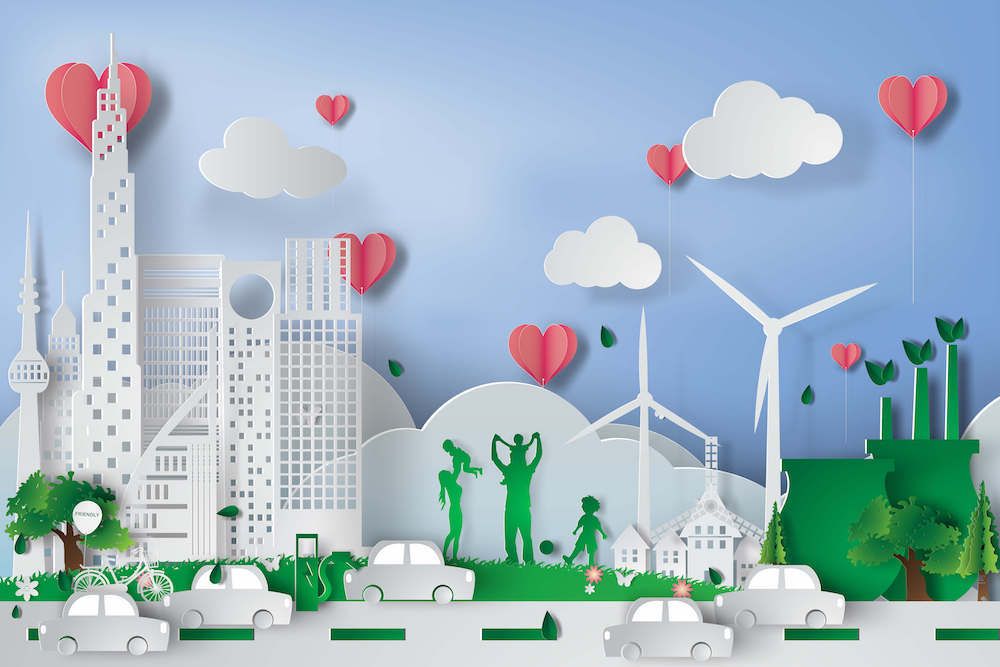Working at home has been a trend that has only found more popularity since the COVID-19 pandemic began. It has its perks, like spending less time commuting and having more time to spend with your loved ones. And if you’re a sasquatch like me and your home is in the woods, then there’s nothing better than spending more time surrounded by nature. But is it better for the environment to work at home than working at an office or other job sites? And how and what are the biggest environment impacts of working from home? We’ll answer these questions (and more) in this sasquatch-approved guide to how the at-home lifestyle impacts the planet.
What are the environmental pros of working from home?
Some of us have found that working from home is better for our lifestyles. Maybe you love getting to sleep in and having the luxury of throwing on a pot of coffee with minutes to spare before getting to work, a.k.a. your desk in the other room (or tree.) This change also gives a lot of us valuable time to spend with our families, pets, and hobbies, creating a better work-life balance. It’s even more satisfying knowing that your enjoyment is helping the earth around you.
One big question that environmentally conscious workers have is, “Does working from home reduce carbon emissions?” Carbon emissions trap heat and increase temperatures around the world, hurting our chances of fighting climate change. The most common way that humans contribute to carbon emissions is by using up electricity and heat, especially through their means of transportation. So, it only makes sense that working from home, which reduces your need for transportation, would lead to a reduction in these carbon emissions.
Data from significant research findings have backed up this belief. One study, published in an Urban Sustainability journal, found that if enough individuals worked from home just four days a week, then they could reduce the amount of nitrogen dioxide, a key pollutant from traffic emissions, by as much as 10%.
There are plenty of smaller additions to the obvious environmental pros of working from home. For example, consider how much less waste you produce by not being in an office. Rather than buying takeout, using plastic cutlery, or dozens of paper coffee cups, you’re able to use long-lasting products that you already have. Additionally, many of us spend more time reading work documents online, saving paper from being wasted.
Decreasing the number of people in the office, and thereby reducing the need for larger office spaces, will also leave an impact. Fewer spaces need to keep their lights, computers, printers, and other energy-using appliances on.
What are the environmental cons of working from home?
Anybody who has worked from home for long enough can tell you that it’s not perfect. There are some more personal cons, like missing face-to-face interactions and hitting a higher step count just from your daily walks around the office. But how and what are the biggest environmental impacts of working from home? While there are a lot of benefits, there are a few downsides to consider.
Most of us will not use enough resources at home to outnumber the waste we produce when going to an office. For most of us, it’s definitely going to be more environmentally friendly to stay at home. But what about the people who aren’t sticking to one spot?
Some people have completely changed their lifestyle thanks to the ability to work from home. We’re seeing more digital nomads than ever before. These are people who are able to do their job remotely and therefore spend more time traveling and working from around the world. Some have no fixed address and will spend time in different cities and towns thanks to the freedom their job has given them. Others are more likely to go on vacations where they keep up the work for 40 hours a week, taking their breaks at the beach or hiking in the woods.
These digital nomads might not belong to an in-person office, but plenty of them do rely on shared coworking spaces. These are offices that allow workers to pay daily, weekly, or monthly rates to use their indoor areas for work, study, conferencing, and more. There are fewer of these coworking spaces than there are traditional offices around the world, but they still use up the same amount of energy as they would if they were one. Some figures suggest that there may be 40,000 of these coworking spaces by 2024. That many spaces will need a lot of energy to function.
Leisurely travel numbers are also rising for the people that aren’t stuck in office spaces. You no longer need to take your vacation days to go on a trip since you can take your laptop anywhere. People are taking more trips, and for longer, which means there are more chances to increase
your ecological footprint. This is especially dangerous for the climate if you’re taking a plane to go on your holiday.
The environmental impact of a single flight is said to increase your footprint by so much that avoiding driving your car for a single year would barely make up for it. Taking enough flights can single-handedly cancel the impacts you’ve made by avoiding your daily drive to work!

Is it better for the environment to work from home?
Based on our list of pros and cons, it seems like working from home is a clear winner. Sure, not everything is perfect when it comes to environmentalism and home offices. Individuals might be spending more on their energy bills, and we’re spending more time looking at screens than ever before.
While the increase in potential air travel does pose a big risk to the benefits of working from home, there are other factors to consider that may cancel it out. Traditionally, people traveling for business reasons have made up 12% of the passengers on planes. You might not have to pay out of pocket for these trips, but the environment certainly does. There are fewer reasons to travel for work now that workplace culture has become more comfortable with virtual meetings.
Corporate travel won’t become a thing of the past, though, as many will still need to take trips for conferences and other events. Research has predicted that we will continue to see around 75% of the number of work flights as before. This 25% drop helps to cancel out some of the environmental impacts of more leisure travel, though more research is needed to determine how different the numbers are.
Based on the air travel numbers, as well as the decrease in daily transportation, it’s enough to give home life the trophy of which is more environmentally friendly. After all, the change has scientists predicting a reduce in carbon emissions that equal up to 51 million metric tonnes every year. Nobody would argue that they like sitting in traffic, and these findings give us another reason to stay away from the wheel.
Some permanent work-from-home employees are even asking themselves if it’s worth owning a car if you aren’t driving it every day. This may mean that multiple-car families are selling at least one of their vehicles, and others are getting rid of theirs altogether. This helps the environmental impact even after the working day has ended.
Is it more sustainable to work from home?
Working from home has been seen as a temporary solution for a lot of companies and workers. Society has spent decades building massive office spaces and relying on in-person work. But workers have proven that doing their jobs from home doesn’t cut productivity and can even increase it in some scenarios.
Various places, including Facebook, Shopify, and Twitter, have committed to letting staff be considered “permanently remote” for as long as they see fit. This means that they will have less of a need for office expansions in the future, decreasing the need for environmentally costly construction on new office sites. Hundreds of thousands of employees will spend less time in their cars driving to work. More rooms will be able to keep the lights off. The culture around work is shifting quickly, and the trend might just be what we need to protect our planet.
Having such large companies move to the at-home method also promotes more green-conscious ideas for future businesses. Climate change continues to be an important conversation both in our everyday lives and during political debates, so emerging companies can start on a good foot by promising to be green conscious. The best way to do this is by letting their employees work from home. They’ll keep their workers happy AND make a difference in the world around them.
Will the work from home trend continue?
A Canadian survey of workers found that 30% of employees around the country were working from home between April 2020 and June 2021. This was compared to only 4% of employees in 2016.
Fewer folks, both humans and sasquatches alike, will continue to work from home at the same rate that they did in 2020 and 2021. This means that some of the benefits that working from home has on the environment will slow down as people return to the office. But there will still be more people outside of the workplace when compared to pre-pandemic numbers, and we’d be shocked if we ever see that 4% figure again.
While not everybody is moving to 100% work from home, plenty of companies have dedicated themselves to a new model of employment. A study found that 74% of companies that employed work-from-home methods during the pandemic will continue to offer the option in some shape or form.
Hybrid models, where people spend some time working in person and at home, are also easy to adopt by companies. Some places will rotate their workers, while others will make mandatory in-office days. This change can apply to existing companies and newer start-ups. It may not be as helpful as fully at-home work, but it does have the potential to make a difference. The hybrid model might also be more appealing to employees who appreciate being able to stay home but find themselves going stir-crazy from spending so many days at home.
How can we stay environmentally friendly if we have to go to the office?
Some workplaces aren’t willing to keep up with the rising demand to work from home. Others are impossible to do away from the office, like positions in health care, retail workers, and education. And let’s face it. Working from home isn’t for everybody. We aren’t all introverted sasquatches, and some of us need those in-person interactions to enjoy our jobs. Thankfully, there are a few ways that we can try to be environmentally friendly when we’re leaving the house every day to go to work.
The biggest impact that you can make when going to work is reconsidering how you get there. Driving to work might be easier, sure. But it’s the most harmful to the environment. Public transportation, like buses and trains, reduces greenhouse gas emissions by taking more cars off the road. Passenger transportation, like driving your regular car to work, make up for 54% of total greenhouse gas emissions. Meanwhile, public transit accounts for only 1%. There are other benefits from making the switch to public transit, too. Just think of the money that you will save on gas! Plus, you can be more productive during this time than you can while driving. You’ll have your hands and eyes free to read books, watch videos, or talk on the phone.
Not a fan of the bus? It doesn’t make sense for everyone. Other environmentally friendly methods of travel that don’t involve public transportation include carpooling with coworkers, riding a bike to work, or switching to a greener car. Not all of the most environmentally friendly cars are electric (though many are.) Different models can be better for the environment based on their fuel efficiency, hybrid battery/gasoline consumption, and more. If you’re in the market for a new car or want to trade yours in, then check out the most recent list of the greenest vehicles that you can find.
Some folks are unable to make the switch from personal vehicles to public transportation. Maybe you live too far away from your workplace to be able to do it, or there are no busses that run close enough to your home. This doesn’t have to mean that you have to give up on being greener and more conscious of your decisions. Smaller ways to make an impact include reusing coffee cups or water bottles and packing your lunch in reusable containers instead of creating unnecessary waste with takeout food. You can also reconsider the amount of time you’re spending behind the wheel outside of work. Walking to the grocery store for shorter trips or going for leisurely walks instead of drives can still help you make a difference.
Finally, it’s never too late to encourage more environmentally friendly practices in the office. Some spaces are implementing green team initiatives to promote more sustainability. Company-wide ideas include changing your products to more environmentally friendly ones, switching to digital documents when possible to reduce the amount of paper you’re printing, and being more diligent with recycling practices. You can always ask your supervisor if a group like this already exists at your workplace. If it doesn’t, then ask yourself if you’re ready to lead one! You might also find yourself having fun while doing it.
Conclusion
You asked, “Is it better for the environment to work at home?” And we answered. There are incredible environmental pros of working from home. The most impactful include the reduction in carbon emissions from taking away your commute and the need for fewer office spaces that use up a lot of electricity. There are a few downsides, like the potential for more airplane trips for digital nomads and increased leisurely travel. But in the end, our planet might be thanking us for switching to the work from home model. Now you can come to spend a day working in the forest with me, and you’ll never want to go back!

